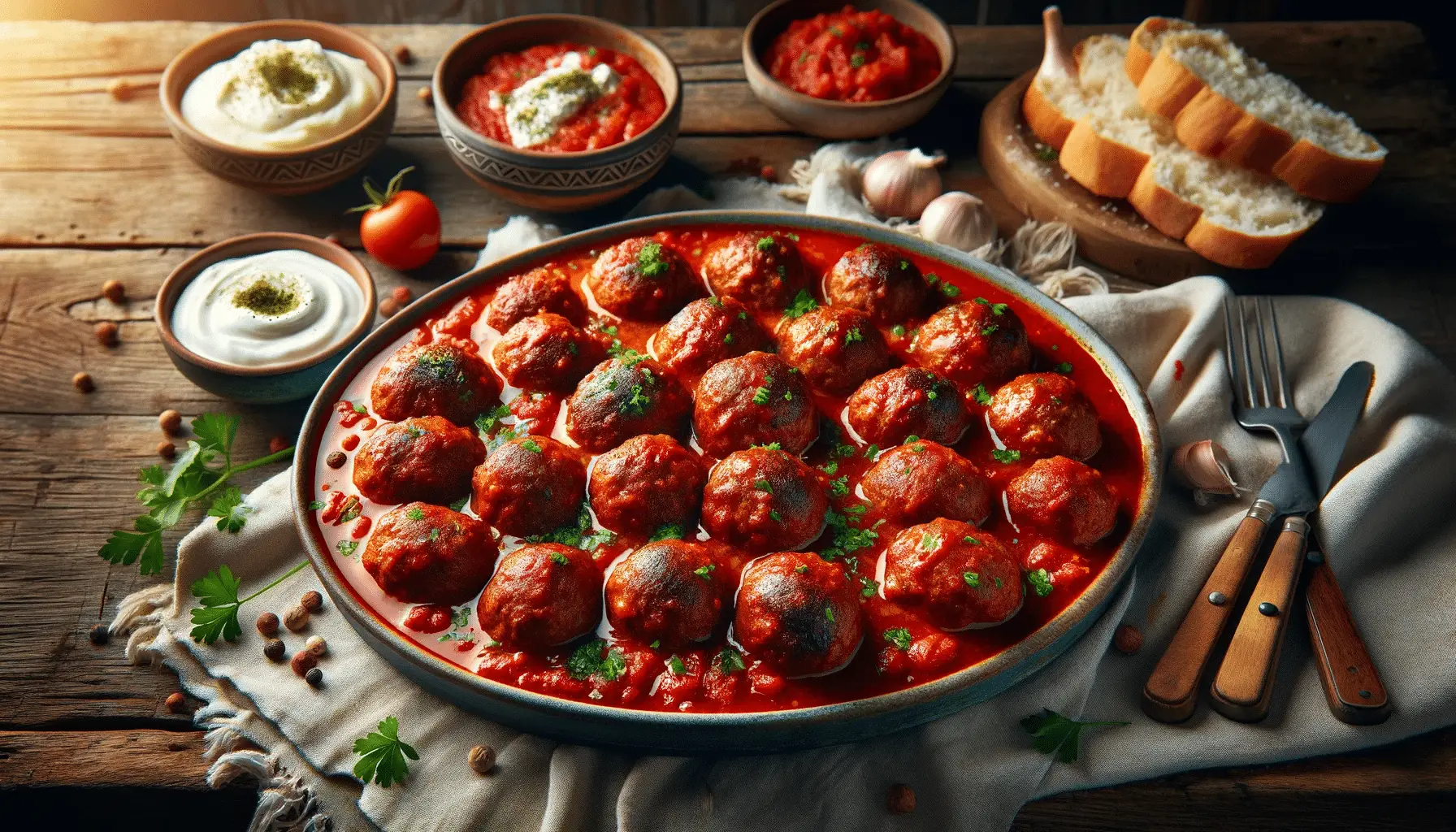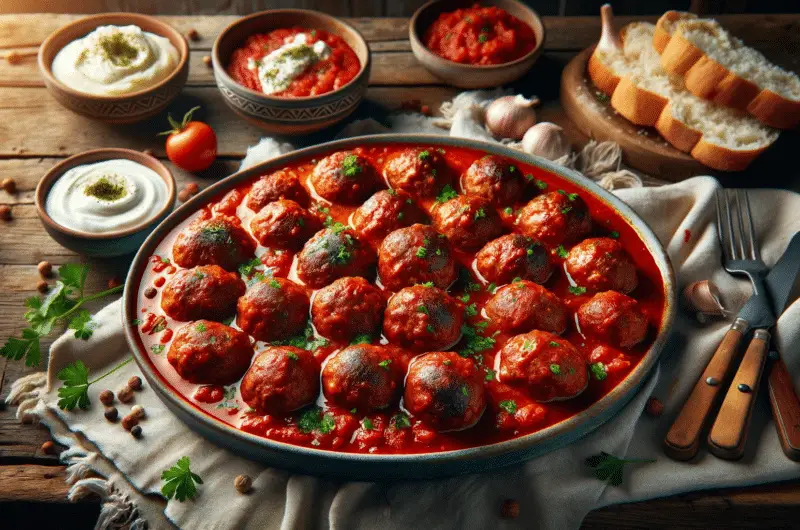In the rich tapestry of Greek cuisine, a particular dish stands out for its robust flavors and intriguing history – Soutzoukakia. This beloved delicacy, a symphony of meat, spices, and sauce, is more than just a culinary delight; it’s a story of cultural fusion and historical evolution. Soutzoukakia, often referred to as Greek meatballs in tomato sauce, is not just a staple in Greek households but a testament to the country’s culinary ingenuity and its ability to transform simple ingredients into a masterpiece of taste.
Historical Background
The story of Soutzoukakia begins in the times of the Ottoman Empire, a period that significantly influenced Greek cuisine. This dish is a prime example of how cultural interactions can give birth to a culinary wonder. The original version, known as “Soutzouk”, hails from the eastern Mediterranean, specifically from the areas that were part of the Ottoman Empire. It was a type of spicy, dried sausage that was popular among the communities in these regions.
When Greeks from Asia Minor migrated to mainland Greece in the early 20th century, they brought with them a plethora of culinary traditions, including the precursor to Soutzoukakia. The Greeks adapted this sausage concept, transforming it into a softer, more palatable version suitable for the Greek palate. The spices were adjusted, and the cooking method shifted from drying to simmering in a rich tomato sauce, thus giving birth to the Soutzoukakia we know today.
This transformation marked a significant moment in the history of Greek cuisine, as it showcased the ability to adapt and evolve recipes based on available ingredients and regional tastes. Over the years, Soutzoukakia evolved further, incorporating more localized flavors and ingredients, becoming a dish uniquely Greek despite its foreign origins.
The journey of Soutzoukakia, from a spiced sausage to a tender meatball simmered in tomato sauce, is emblematic of the cultural exchange that has historically enriched Greek culinary practices. It’s a dish that not only satisfies the palate but also tells a story of migration, adaptation, and culinary innovation.
Cultural Significance
Soutzoukakia holds a special place in Greek culinary tradition, often symbolizing the warmth and generosity of Greek hospitality. In Greek culture, food is more than sustenance; it’s a reason to gather, celebrate, and share. Soutzoukakia is frequently featured in family gatherings, local festivals, and religious celebrations. Each bite of these succulent meatballs carries the essence of Greek communal values and the joy of shared meals.
Interestingly, Soutzoukakia is also a dish that tells the story of resilience and adaptation. The recipe, which originated during challenging historical times, represents the Greek spirit of making the most out of available resources. This aspect resonates deeply in Greek households, where the dish is often cooked with personal touches, making it a part of family legacies and culinary heritage.
Ingredients and Variations
The classic recipe for Soutzoukakia involves a blend of ground meat (usually beef or a mix of beef and pork), breadcrumbs, garlic, and a variety of spices like cumin, cinnamon, and sometimes allspice. The meatballs are then simmered in a rich tomato sauce, often infused with more garlic and herbs.
However, like any traditional dish, Soutzoukakia has seen numerous regional variations. Some variations incorporate local cheeses, while others include a splash of wine in the sauce for added depth. In certain parts of Greece, a hint of mint or oregano is added to the meat mixture, bringing a fresh dimension to the dish.
Modern takes on Soutzoukakia have also emerged, with chefs and home cooks experimenting with ingredients like lamb or adding contemporary twists like serving the dish with pasta or over a bed of creamy mashed potatoes.
Preparation Method
The art of making Soutzoukakia lies in the balance of flavors and textures. The process begins with mixing the ground meat with breadcrumbs, eggs, minced garlic, and a blend of spices. This mixture is then shaped into oblong meatballs, a unique feature of Soutzoukakia compared to the more common round shape.
The meatballs are lightly browned in olive oil, then set aside. In the same pan, a sauce is prepared using tomatoes, garlic, onions, and herbs. The meatballs are then simmered in this sauce until they are cooked through and tender, allowing the flavors to meld beautifully.
A key tip for achieving the best Soutzoukakia is to ensure the meatballs are moist and the sauce is rich and flavorful. Some cooks recommend using a combination of beef and pork for juicier meatballs, and simmering the sauce slowly to develop a deeper flavor.
Serving and Pairing
Soutzoukakia is traditionally served hot, often accompanied by a side of pilaf, roasted potatoes, or crusty bread to soak up the rich tomato sauce. In more contemporary servings, it’s not uncommon to find Soutzoukakia served over pasta, merging Greek tradition with a nod to Italian influence.
When it comes to pairing, a medium-bodied red wine is a classic choice. Greek wines, such as Agiorgitiko or Xinomavro, complement the dish’s robust flavors perfectly. For a lighter meal, Soutzoukakia can be paired with a refreshing Greek salad, providing a crisp contrast to the meaty, spiced flavors of the dish.
Nutritional Information
Soutzoukakia, while hearty and flavorful, is also a nutritionally dense dish. The meat provides a good source of protein, essential for muscle building and repair. However, it’s important to note that this dish can be high in calories and fat, depending on the meat used and the amount of oil in cooking. Moderation is key, and for those looking for a healthier version, leaner cuts of meat or a combination of meat and plant-based proteins can be used.
The Evolution and Adaptation of Soutzoukakia
As with many traditional dishes, Soutzoukakia has undergone its own evolution as it has passed through generations and crossed regional boundaries. This evolution is not just in terms of ingredients or preparation methods, but also in its significance in contemporary Greek cuisine. Today, chefs and home cooks alike take pride in adding their own creative spins to this classic, whether it’s through incorporating unconventional spices, experimenting with different meats, or presenting the dish in a modern culinary context.
Soutzoukakia in the Modern Culinary World
In the modern culinary landscape, Soutzoukakia has found its place both in traditional Greek tavernas and in fine dining establishments. It’s a dish that has the unique ability to bridge the gap between home-cooked comfort food and gourmet cuisine. This adaptability speaks to the versatility and enduring appeal of Soutzoukakia. It’s not uncommon to find this dish being celebrated in food festivals, both within Greece and in Greek communities around the world, showcasing the global reach of Greek cuisine.
Soutzoukakia and Health-Conscious Cooking
In an era where health-conscious cooking is becoming increasingly important, Soutzoukakia has also seen adaptations that make it suitable for various dietary requirements. Chefs and home cooks are experimenting with plant-based versions, using lentils or beans as a substitute for meat. There are also gluten-free variations, where breadcrumbs are replaced with alternative binders like gluten-free oats or almond flour. These adaptations ensure that Soutzoukakia remains relevant and accessible to a wider audience, without losing its essence.
Conclusion: The Legacy of Soutzoukakia
Soutzoukakia is more than just a dish; it’s a cultural emblem that encompasses history, tradition, and the evolution of Greek cuisine. Its story is one of adaptation, resilience, and the unifying power of food. As families continue to pass down the recipe, each version of Soutzoukakia carries with it the memories, stories, and love of those who have made and shared it. It remains a beloved staple in Greek households, a favorite in restaurants, and a proud representation of Greek culinary tradition on the global stage. In every meatball simmered in savory tomato sauce lies a piece of Greek history, a taste of home, and a reminder of the simple yet profound joys of cooking and eating together.


